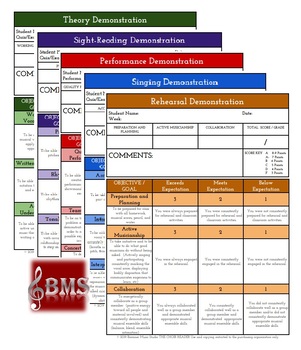Assessment Rubrics for Choir Programs
- Zip
Products in this Bundle (5)
Description
Assigning grades in the choir classroom can be difficult. When that parent calls you and asks about their child's grade you need to be able to have a clear explanation. Let's face it: What IS the difference between the grade of "94" and a "95"? I wrestled with this monster for several years, and what I came up with is 15 "goals" that each singer works toward regardless of the concert cycle, complexity of the music, level of musicianship in the ensemble, theory concept, or sight-reading difficulty. If all students are working toward the mastery of these concepts, they will have fun, and great music will happen!
I took these 15 concepts and divided them into the 5 different areas that we as choir directors assess: Rehearsal Assessment, Sight-Singing Quizzes, Theory Quizzes, Singing or Part Tests, and Performance Assessment. Each rubric looks specifically at 3 of the primary “goals”.
These rubrics are designed to be in student language. After all, the rubric is to be providing clear feedback for the student, and the idea of a rubric is that it is objective to both the teacher and the student. When it is clear that the objective is achievable, and that the rubric stands on its own (no matter who uses the rubric, all arrive at the same assessment), the director is seen much more as an advocate and coach, than a force to be overcome.
The simplicity of these rubrics have been fantastic for me and have saved much time and headache. I use them in an electronic format that is automatically sent out to students and parents by email when I complete the assessment process. In order to share them with you, I have put them in a format in which you would print them off and write in them if you desire. This could turn into alot of paper and writing. Another ideas is that you share these rubrics with the students so they have them for reference, and then just communicate their scores for each column and any comments you have for them electronically.
One quick note because I predict some comments about my choice of words in the rubric. I deeply believe in setting high expectations! That being said, I believe in having expectations that can be realistically attained by real people who have real lives with real limitations in real schools. Student initiation and creative contribution is most beautiful and powerful when it is in addition to the clearly known expectation. If students are constantly only able to live within the confines of the director's range of expectation, or especially if there is no hope for branching out beyond the laid out minimal expectations, students will be miserable indeed--as will the director by trying to force creativity down on the students. Perhaps think of the bar of expectation as being ground level. Living underground is no fun and sure is dark! Above ground is limitless heights where your students' creativity and initiative can soar and provide inspiration for everyone who observes! So instead of "do this or else"... It becomes "what happens if?... woah! that was awesome!" Once your singers have this vision and know that you are a clear advocate for their creativity... WOW! And you get to be there to keep teaching them and encouraging them to fly and orchestrating opportunities for them to spread their wings and change lives!
I wish you the best!
Here are the 15 concepts all together:
15 Concepts for Every Choir Singer to Master
Accuracy: To be able to sing your part accurately.
Intonation: To be able to use correct vocal technique to accurately perform in tune. (breath support, centered pitch, tone quality, etc.)
Interpretation: To be able to perform the music with creative expression, incorporating the musical elements we talked about in rehearsal. (dynamics, phrasing, diction, etc.)
Preparation and Planning: To be prepared for class with all homework, musical scores, pencil and water.
Active Musicianship: To take initiative and to be able to do what good musicians do without being asked. (Actively singing and participating, consistently marking the vocal score, displaying bodily disposition that communicates eagerness to learn, etc.)
Musical Collaboration: To energetically collaborate as a group member (positive energy toward all people and material involved) and consistently demonstrating musical ensemble skills (balance, blend, ensemble intonation)
Pitch: To be able to read and sing pitches accurately.
Rhythm: To be able to read and sing rhythms accurately.
Tonal Center: To be able to read and sing with accurate intervallic relationships and to be able to stay in the same key when singing.
Working Vocabulary: To be able to know musical vocabulary and apply each term appropriately.
Written Accuracy: To be able to write musical notation that is accurate and easy to read.
Active Understanding: To be able to demonstrate active understanding of music theory concepts by writing and performing them.
Quality Performance: To be able to contribute in creating a quality performance through poise, showmanship and musical excellence.
Team Player: To be on time, prepared, problem solving, and to demonstrate self-control in order to make the best possible experience for all involved.
Concert Etiquette: To demonstrate appropriate audience behavior throughout the entire concert (listening attentively, etc.). To offer positive feedback to other performers before, during and after the concert.


